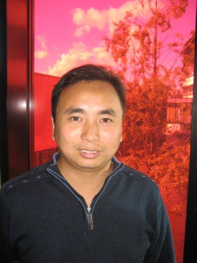Oxygen surface exchange and oxidative dehydrogenation on oxide ion conductors
Promotion date: 17. October
Promotor: Prof.dr.ir. Arian Nijmeijer
Assistant promotor: Dr.ir. Henny J.M. Bouwmeester
| The research mainly aims at investigation of the rate of oxygen exchange at the surface of oxide ion conductors. A fast and simple method, referred to as pulse 18O-16O isotopic exchange (PIE), for measurement of the rate of surface exchange on oxide ion conductors has been developed. The method comprises measuring the response to feeding an 18O-enriched gas phase pulse through a continuous flow packed‑bed micro-reactor, loaded with the oxide powder, by on-line mass spectrometry. For two mixed conductors, La2NiO4+d and BSCF, the exchange reaction is limited by the rate of dissociative adsorption of O2 molecules at the oxide surface, whilst for the solid electrolyte, YSZ, this reaction is competing with that of incorporation of adsorbed oxygen atoms into the oxide lattice. The PIE method is used for measurement of the oxygen exchange rate of phases La1-xSrxCoO3- (LSC), and the PIE method is used for in-situ assessment of the role of CO2 on the rate of oxygen exchange on BSCF. Further: the oxidative dehydrogenation (ODH) reactions of propane and ethane are investigated in a catalytic membrane reactor, incorporating oxygen-permeable membranes. The results show the dominating role of the oxygen flux across the membrane and that of available sites at the membrane surface in primary activation of the alkane. The experimental data can be reconciled by the so-called Mars-van Krevelen mechanism, in which the alkane reacts with lattice oxygen to produce the corresponding olefin. |
Was your work application oriented?
Yes, in some way it was. We developed a microreactor of the flow packed-bed reactor, to measure the oxygen surface exchange. The idea was developed some years ago by dr. Bernard Boukamp. We were able to perform a fast measurement, very useful for science as well as for practical purposes.
Were you able to have some nice publications?
One article was published in Physical Chemistry Chemical Physics, PCCP. Two other articles are under way to be published in other magazines.
Also I am proud to be invited as a key-note speaker on an international conference on Inorganic Membranes in Tokyo, Japan.
What are your future plans?
I already work as a chief engineer at the Luoyang Longmen Fe-Alloy (Thailand) Co.Ltd . The company is Chinese from origin.
Also I am working as a designer and engineer at a company belonging to a good friend of mine. This company is doing very well on bringing to the market a membrane installation, separating water and salt from wastewater and process water in chemical factories. A lot of these osmoses installations are sold already. All in all, one can say I am a flex-worker now.
What, in your opinion, is important for Mesa+ to stay successful in future?
I learned a great deal from the conferences and talking to expert people. Also, I had a great opportunity to broaden my knowledge, by reading and by experimenting. In this way I can be of technical help in my home country China. By the open atmosphere of research I learned to communicate, not being shy anymore if people ask questions. I think, that is important for Chinese workers in general, including researchers and designers. Mesa+ can be of great impact internationally this way.
Also Mesa+ can contribute to the own region and nation, by helping companies on their research questions.

